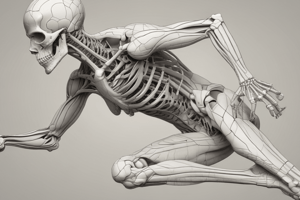Podcast
Questions and Answers
Which characteristic is shared by all synovial joints?
Which characteristic is shared by all synovial joints?
- Motion in multiple planes
- Bony fusion
- A capsule containing synovial fluid (correct)
- Cartilaginous connection
Gliding joints allow for rotational movement.
Gliding joints allow for rotational movement.
False (B)
What type of synovial joint is found at the base of the thumb?
What type of synovial joint is found at the base of the thumb?
saddle
A hinge joint allows for _ ______ _ and extension.
A hinge joint allows for _ ______ _ and extension.
Match the following synovial joint types with their respective examples:
Match the following synovial joint types with their respective examples:
Which movement is NOT possible at a hinge joint?
Which movement is NOT possible at a hinge joint?
The hip joint is an example of a condyloid joint.
The hip joint is an example of a condyloid joint.
What is the main function of synovial fluid within a synovial joint?
What is the main function of synovial fluid within a synovial joint?
Flashcards
Synovial Joints
Synovial Joints
The main joints in the body, featuring a capsule filled with synovial fluid for lubrication.
Hinge Joint
Hinge Joint
A type of synovial joint that allows movement in one plane (flexion and extension).
Pivot Joint
Pivot Joint
Allows rotation of one bone around another; a process rotates in a socket.
Gliding Joint
Gliding Joint
Signup and view all the flashcards
Saddle Joint
Saddle Joint
Signup and view all the flashcards
Condyloid Joint
Condyloid Joint
Signup and view all the flashcards
Ball and Socket Joint
Ball and Socket Joint
Signup and view all the flashcards
Movement Types
Movement Types
Signup and view all the flashcards
Study Notes
Synovial Joints
- Synovial joints are joints where the surfaces meet in a capsule, resembling an "egg-like" shape. Synovial fluid acts as a lubricant.
- There are 6 types of synovial joints: Hinge, Pivot, Gliding, Saddle, Condyloid/Ellipsoid, and Ball & Socket.
Hinge Joint
- Shape: Moves in one plane only.
- Example: Interphalangeal, elbow
- Movement: Flexion, extension
Pivot Joint
- Shape: A process rotates in a socket.
- Example: Atlas/axis; radius/ulna
- Movement: Rotation
Gliding Joint
- Shape: Two flat surfaces slide against each other.
- Example: Intercarpal joints; also between tarsals
- Movement: Gliding movements
Saddle Joint
- Shape: A saddle-like ridge, the "rider" has a corresponding hollow.
- Example: Base of thumb
- Movement: Flexion, extension; abduction, adduction; "sort of" circumduction
Condyloid/Ellipsoid Joint
- Shape: A modified ball & socket with an oval shaped ball.
- Example: Radius/carpals; temporomandibular joint; metatarsals/phalanges
- Movement: Flexion, extension; abduction, adduction; limited circumduction
Ball & Socket Joint
- Shape: Rounded head fits in a cup-shaped cavity.
- Example: Shoulder - humerus/scapula; Hip - femur/pelvis
- Movement: Flexion, extension; abduction, adduction; rotation; circumduction
Studying That Suits You
Use AI to generate personalized quizzes and flashcards to suit your learning preferences.




